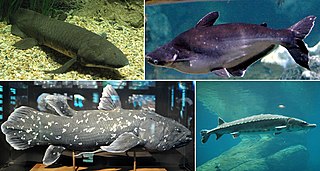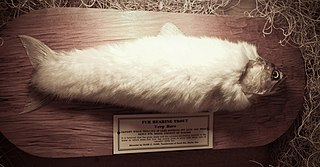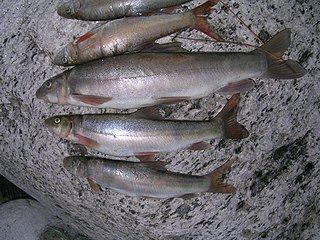
Osteichthyes, popularly referred to as the bony fish, is a diverse taxonomic group of fish that have skeletons primarily composed of bone tissue. They can be contrasted with the Chondrichthyes, which have skeletons primarily composed of cartilage. The vast majority of fish are members of Osteichthyes, which is an extremely diverse and abundant group consisting of 45 orders, and over 435 families and 28,000 species. It is the largest class of vertebrates in existence today. The group Osteichthyes is divided into the ray-finned fish (Actinopterygii) and lobe-finned fish (Sarcopterygii). The oldest known fossils of bony fish are about 420 million years old, which are also transitional fossils, showing a tooth pattern that is in between the tooth rows of sharks and bony fishes.

Fishing is the activity of trying to catch fish. Fish are often caught in the wild but may also be caught from stocked bodies of water. Techniques for catching fish include hand gathering, spearing, netting, angling and trapping. “Fishing” may include catching aquatic animals other than fish, such as molluscs, cephalopods, crustaceans, and echinoderms. The term is not normally applied to catching farmed fish, or to aquatic mammals, such as whales where the term whaling is more appropriate. In addition to being caught to be eaten, fish are caught as recreational pastimes. Fishing tournaments are held, and caught fish are sometimes kept as preserved or living trophies. When bioblitzes occur, fish are typically caught, identified, and then released.

Gnathostomata are the jawed vertebrates. The term derives from Greek: γνάθος "jaw" + στόμα "mouth". Gnathostome diversity comprises roughly 60,000 species, which accounts for 99% of all living vertebrates. In addition to opposing jaws, living gnathostomes have teeth, paired appendages, and a horizontal semicircular canal of the inner ear, along with physiological and cellular anatomical characters such as the myelin sheaths of neurons. Another is an adaptive immune system that uses V(D)J recombination to create antigen recognition sites, rather than using genetic recombination in the variable lymphocyte receptor gene.

The fur-bearing trout is a legendary creature purportedly found in American folklore and Icelandic folklore. According to folklore, the trout has created a thick coat of fur to maintain its body heat. Tales of furry fish date to the 17th-century and later the "shaggy trout" of Iceland. The earliest known American publication dates from a 1929 Montana Wildlife magazine article by J.H. Hicken. A taxidermy furry trout produced by Ross C. Jobe is a specimen at the Royal Museum of Scotland; it is a trout with white rabbit fur "ingeniously" attached.

The rainbow trout is a trout and species of salmonid native to cold-water tributaries of the Pacific Ocean in Asia and North America. The steelhead is an anadromous (sea-run) form of the coastal rainbow trout(O. m. irideus) or Columbia River redband trout (O. m. gairdneri) that usually returns to fresh water to spawn after living two to three years in the ocean. Freshwater forms that have been introduced into the Great Lakes and migrate into tributaries to spawn are also called steelhead.

Fish are gill-bearing aquatic craniate animals that lack limbs with digits. They form a sister group to the tunicates, together forming the olfactores. Included in this definition are the living hagfish, lampreys, and cartilaginous and bony fish as well as various extinct related groups. Around 99% of living fish species are ray-finned fish, belonging to the class Actinopterygii, with over 95% belonging to the teleost subgrouping.

Cypselurus is a genus of flying fish in the family Exocoetidae.

Schizothorax is a genus of cyprinid fish found in southern and western China, through northern South Asia (Himalaya) and Central Asia, to Iran, with a single species, S. prophylax, in Turkey. They are primarily found in highland rivers, streams and lakes, although a few species occur in lower-lying locations, like Lake Balkhash and lakes of the Sistan Basin. Their scientific name means "cloven-breast", from Ancient Greek schízeïn (σχίζειν) "to cleave" and thórax (θώραξ) "breast-plate". The western species are typically referred to as marinkas from their Russian name marinka (маринка), while the eastern species are usually called snowtrout. Although they do resemble trouts in habitus this is merely due to convergent evolution and they are by no means closely related apart from both being Teleostei: Cyprinids are in the teleost superorder Ostariophysi, while trouts are in the superorder Protacanthopterygii. Their ancestors must thus have diverged as early as the Triassic, more than 200 million years ago.
Schizothorax longibarbus is a species of ray-finned fish in the genus Schizothorax.

Robert Anthony Fish is an American professional wrestler. He is currently signed to WWE, where he competes on the NXT brand. He is a member and co-founder of The Undisputed Era.

Pescetarianism is the practice of using seafood as the only source of meat in a diet that is otherwise vegetarian.
Parasinilabeo is a genus of cyprinid fish endemic to China. There are currently six described species in this genus
Ptychidio is a genus of cyprinid fish endemic to China.
Rectoris is a genus of cyprinid fish found in China and Vietnam.
Parasinilabeo longicorpus is a species of cyprinid fish endemic to China.
Parasinilabeo longiventralis is a species of cyprinid fish endemic to the Fuchuanjiang River in China.
Parasinilabeo maculatus is a species of cyprinid fish endemic to China.
Parasinilabeo microps is a species of cyprinid fish endemic to China.
Ptychidio longibarbus is a species of cyprinid of the genus Ptychidio. It inhabits China, has a maximum length of 16.8 centimetres (6.6 in) and is considered harmless to humans.
Rectoris longibarbus is a species of cyprinid of the genus Rectoris. It inhabits Guangxi Province, China has a maximum length of 13.0 centimetres (5.1 in) and is considered harmless to humans.









